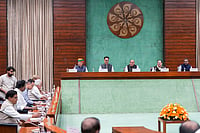Studio BEAD, a pioneering name in the intersection of art, craft, and contemporary practices, continues to challenge conventional narratives. Through the Odisha Craft Odyssey, Studio BEAD aims to integrate and elevate traditional craft practices in contemporary flair, ensuring that they receive the recognition they deserve within the broader artistic discourse. We sat down with Premjish Achari, the visionary curator behind the Odisha Craft Odyssey residency, to explore his approach, strategies, and the transformative potential of this project.
Q: How do you interpret the curatorial vision of this residency, particularly the integration of craft practices into contemporary art?
I prefer to use the term "inclusion" over "integration" when discussing the positioning of craft within the domain of art. This residency aims to question and dismantle the hierarchical distinctions often made between high art and craft. By emphasizing that these fields are not separate but complementary, we seek to elevate craft practices to the same level of critical and creative discourse as modern and contemporary art. The curatorial vision challenges the existing demarcations and misrepresentations by highlighting the significant artistic and cultural value inherent in craft. Our goal is not just to correct the historically marginalized position of the artisan but to complicate the cultural field by asking what truly constitutes art today. Through exhibitions, open studios, and educational activities, we aim to demystify craft practices and interrogate their representation in intellectual history, exhibition practices, and policymaking.
Q: How do you approach collaboration with artisans or traditional craftsmen in your practice?
Collaboration is often misconstrued as a purely harmonious process, but I view it as a space where tensions and differences can be articulated. Effective collaboration is built on reciprocal learning, where both parties share their knowledge to co-create or co-learn. This residency facilitates ongoing dialogue, respecting the artisans' space and methods while fostering a symbiotic relationship. We strive to map out the commonalities and peculiarities of each domain, valuing the context of each participant's expertise. By imagining newer contexts, we aim to create unique outcomes that speak to our times.
Q: What strategies would you employ to ensure ethical and respectful engagement with the community?
Trust and transparency are the foundations of our approach. Artisan communities in India have often been wary of research projects, having been exploited in the past. We are committed to open communication, sharing our vision, expectations, and potential impacts with all stakeholders. We actively engage with community leaders and office bearers to ensure that their sensitivities are respected. Moreover, we ensure fair compensation, recognition, and ethical guidelines for their time, recognition of sharing of knowledge and collaboration along with documentation and representation. This approach aims to nurture a respectful and mutually beneficial relationship.
Q: What steps would you take to ensure that the voices and expertise of the artisans are amplified in your project?
We are committed to ensuring that artisans are not only represented but also actively participate in the project. The residents work closely with the artisans, incorporating their insights into their presentations and final open studio projects. We aim to provide platforms for engendered artisans to speak at public events and exhibitions, giving them a direct voice to articulate the intricacies of their work and context directly. By fostering an environment of collaboration, we ensure that artisans are not passive partners but co-creators in the process. Residents are constantly engaged with the community listening to stories, experiences and ideas ,ensuring they do not remain faceless in the exhibition and talks.
Q: Given the two-phase structure of the residency, how do you plan to manage the transition from working directly with artisans in Balakati to preparing for the Open-Day event in Bhubaneswar?
The Open-Day event at the Lalit Kala Akademi Gallery will showcase the studies, outputs, and discussions generated throughout the residency. While the residency is primarily engaged with the bell metal cluster in Balakati, residents will periodically present their research and fieldwork to the community at the local center. The open studio is an extension of this ongoing engagement, expanding these activities to the gallery with the active participation of the artisan community.
Q: What lasting impact do you hope your project will have on the bell metal community and broader perceptions of craft?
This residency marks the beginning of a longer engagement with Odisha's craft clusters. While we do not expect immediate lasting impact, we aim to foster strong relationships with the community, laying the groundwork for future initiatives. Our focus is on understanding the complexities of bell metal practices, including economic networks, metallurgy, social positions, and the world of objects they create. The long-term impact will be realized through sustained communication, structured residencies, exhibitions, and conferences that reevaluate the position of crafts in artistic discourse, create new economic opportunities, and contribute to valuable research.
Q: In what ways do you think contemporary art can challenge or reinforce the existing hierarchies between art and craft?
The expanded field of contemporary art offers immense possibilities to include various practices, including craft. The pluralistic nature of contemporary art allows for the dismantling of boundaries that have marginalized crafts, often due to their association with lower caste communities. The paradigmatic shifts in contemporary art, which focus on marginalized subjects and makers rather than the object domain, have been revolutionary. Contemporary art, with its inherent pluralism and elasticity, has the potential to blur the boundaries between art and craft, challenging existing hierarchies.
Q: How can design interventions help in preserving and evolving traditional crafts without losing their essence?
Design and craft practices can benefit from each other through collaborative and equal partnerships. While mainstream design has often appropriated craft or focused solely on its utility, sensitive collaborations can enhance innovation by exploring new applications, forms, and functions. This approach allows craft to evolve from its traditional roles, making it dynamic and relevant. Exposure to design knowledge, technology, and markets can empower craftspeople to broaden their creative horizons and redefine their roles and positions.
Q: What previous research experiences have prepared you for this project, particularly in working with traditional craft communities?
My academic and curatorial experiences have provided a strong foundation for this project. My early involvement in exhibitions, such as the documentation of Ramkinkar Baij by Devi Prasad, and my research on the Vishwakarma community of medieval Kerala, have shaped my understanding of the marginality of craftspersons in Indian society. My work has consistently aimed to debunk existing binaries, such as art-craft and artist-artisan, and introduce new concepts to reimagine the studies, exhibitions, and policies on craft. My involvement in the GRID Heritage project and other initiatives has further deepened my understanding of how to approach heritage, context, and collaboration in craft practices.
Q: What frameworks will you use to analyze the intersection of craft practices with broader cultural and economic contexts?
An interdisciplinary framework is essential for a project of this nature, which aims to have multiple levels of impact. Rooted in a critical approach, our analysis will interrogate how craft practices have been misrepresented and how the art-craft dichotomy has been constructed. By examining social relations, modes of production, canonical narratives, and institutional frameworks, we can reevaluate the cultural and intellectual history that shapes perceptions of art and craft. Our goal is to develop new methods of research and ethical, collaborative practices that can guide future studies and initiatives.
Studio BEAD' Vision for the Future
The Odisha Craft Odyssey is more than a residency; it is a bold statement on the need to rethink and reposition craft within the broader artistic discourse. Studio BEAD along with MGM Foundation, under the curatorial guidance of Premjish Achari, is leading this conversation with a vision that respects tradition while embracing contemporary possibilities. Through this project, the hope is to foster long-lasting relationships, challenge existing hierarchies, and create a new paradigm where art and craft are seen as equal contributors to cultural and creative expression.
















